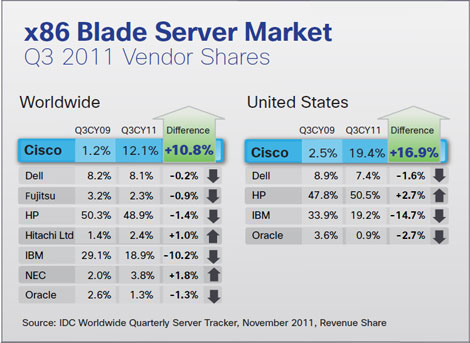
This graphic from Cisco Systems shows the customer growth for the company's Unified Computing System servers and switches.
In two years, Cisco Systems' entry into the blade server arena has won it a 12.2 percent share of the x86 server market. This week Cisco (CSCO) announced that it has surpassed 10,000 customers worldwide for its Unified Computing System (UCS), which brings servers, storages and switches together in a converged data center infrastructure.
Cisco used the milestone as an opportunity to highlight its progress in the server market, where it has made inroads into the dominance of the two leaders, HP and IBM. Most of those gains appear to have come primarily at the expense of IBM, whose market share has slipped as Cisco's has gained, according to quarterly data from IDC (see chart below).
Major Progress vs. Big Expectations
When it was introduced in 2009 by Cisco CEO John Chambers the new UCS architecture was touted as an “inflection point” for virtualization that would transform the data center. At the time, DCK described it as "the latest step in a larger battle for the data center, with Cisco seeking to position its technology at the heart of a virtualized infrastructure doing business on the Inter-Cloud of the future."
There's no question that Cisco raised expectations by throwing the full weight of its considerable marketing might behind UCS. Has Cisco's progress met those lofty expectations? Since then UCS has gained 10.8 percent in the worldwide market share of x86 blade servers and 16.9 percent in the United States, according to the IDC data. That's a meaningful presence in a sector that is growing faster then the broader server market.
Battle for the Data Center
Ciso's entry into the server market also shook up many of the vendor relationships within the larger data center ecosystem. HP and IBM have since taken steps to bolster their networking and converged computing offerings to provide alternatives to Cisco. The impact of Cisco's push into blade servers will likely be best measured on a longer time frame and broader scale. But today's announcement reinforces Cisco's status as an increasingly important player in the server market.
The Unified Computing System brings together hardware – including the B-Series blade server and network adapters – that seamlessly connect with storage systems over a high-speed unified network fabric powered by Cisco’s Nexus family of switches, enabling virtualized assets to move seamlessly across the data center and the Internet. UCS is part of Cisco's larger vision for the combined Unified Data Center, along with its unified fabric and unified management framework.
The UCS family portfolio has had additions made to it and a number of enhancements while it evolved and gained market share. At Cisco Live 2011 while talking about UCS updates Cisco CTO Padmasree Warrior s explained that the network of the future will focus on programmability, virtualization and configuration/automation.

A Cisco graphic highlighting its market share gains in the x86 server market, where it has built the third-largest market share after HP and IBM.e
Data Center Knowledge's John Rath contributed to this story.




